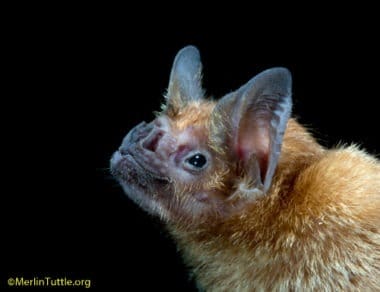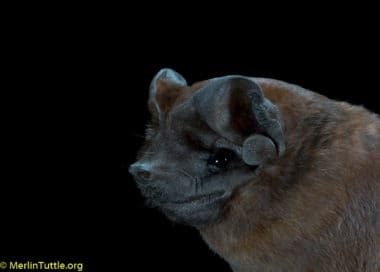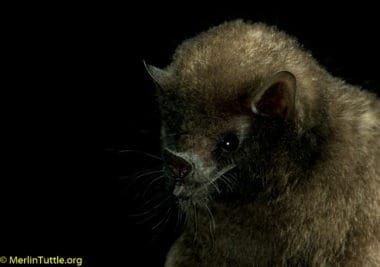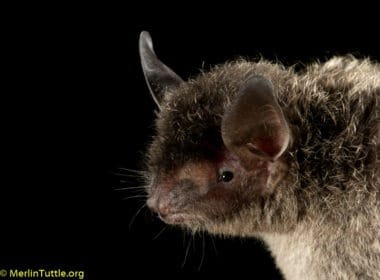Challenging torrential rains countered by cooperative bats in Costa Rica
Merlin and MTBC team members spent 19 days in Costa Rica last November on a filming trip for “Bat City” with its Director and Emmy
We’re just finishing up an incredible first week at Cocobolo and already caught 44 species of bats, everything from fishing bats to vampires, not to mention a wide variety of fruit, nectar, and insect eaters. Merlin added 10 additional species to his collection! Pygmy fruit-eating bats were found roosting in leaves they had cut to form “tents”.
Chestnut short-tailed bats were all around camp, feeding on piper fruit.
We caught more than 20 Common vampire bats. Frontier campesinos keep a few livestock not too far away, explaining the presence of so many vampires. Most of these seem to have lots of personality, enabling Merlin to get this cool photo. The trip participants had loads of fun shooting videos of the vampires running around on the ground on all fours.

Bonda mastiff bats were netted drinking and feeding over a nearby river. These are very fast flying insect eaters that normally feed high over the forest.

Many Salvin’s big-eyed bats are found as they search for fruit in the forest. Despite their big eyes, these bats are exceptionally difficult to photograph because they tend to shut their eyes when held for a photo.
Greater sac-winged bats were common everywhere we went, including five that roosted in our shower stalls.
Rhogeesa tumida is one of the smallest Central American bats. It weighs less than a US nickel (about four grams). This tiny insect-eating bat generally avoids capture in traditional mist nets, but was captured in our ultra-fine monofilament mist net.

This Dark long-tongued bat was one of several nectar-feeding species that we netted between our tents among flowering banana plants. This was only the second one of this species that Merlin had seen.

The Silver-tipped myotis was one of the species that appeared to be feeding on small mayflies over the river.
We caught our last fishing bat on the next-to-last night for Group 1. They’re expert at avoiding even the finest of mist nets. Everyone especially enjoyed seeing the first fishing bat of the trip. Notice their huge feet and claws. These bats have flattened toes and very sharp claws for snatching minnows from the water. This is one of the areas largest species with nearly 3/4 of a meter wide wingspan.
Love our content? Support us by sharing it!
Merlin and MTBC team members spent 19 days in Costa Rica last November on a filming trip for “Bat City” with its Director and Emmy
“Just like the old days, eh Heather?” Kent softly clicks his tally counter as he sits in his folding chair on the other side of
Bats can use sounds in many complex ways. They can sing and even have different dialects… When imagining a bat, the first thoughts that come
It was a long road to Austin, Texas. More than five years after my first introduction to Merlin Tuttle’s Bat Conservation as a teenager, I packed
2024 © Merlin Tuttle’s Bat Conservation. All rights reserved.
Madelline Mathis has a degree in environmental studies from Rollins College and a passion for wildlife conservation. She is an outstanding nature photographer who has worked extensively with Merlin and other MTBC staff studying and photographing bats in Mozambique, Cuba, Costa Rica, and Texas. Following college graduation, she was employed as an environmental specialist for the Florida Department of Environmental Protection. She subsequently founded the Florida chapter of the International DarkSky Association and currently serves on the board of DarkSky Texas. She also serves on the board of Houston Wilderness and was appointed to the Austin Water Resource Community Planning Task Force.
Michael Lazari Karapetian has over twenty years of investment management experience. He has a degree in business management, is a certified NBA agent, and gained early experience as a money manager for the Bank of America where he established model portfolios for high-net-worth clients. In 2003 he founded Lazari Capital Management, Inc. and Lazari Asset Management, Inc. He is President and CIO of both and manages over a half a billion in assets. In his personal time he champions philanthropic causes. He serves on the board of Moravian College and has a strong affinity for wildlife, both funding and volunteering on behalf of endangered species.